Americans say their cell phones aid them during emergencies and fill in their free time, but many also report driving unsafely while on their cells and they say they don’t like the new intrusions and public annoyances cell phones bring to their lives – not to mention their monthly bills.
The cell phone has become an integral and, for some, essential communications tool that has helped owners gain help in emergencies. Fully 74% of the Americans who own mobile phones say they have used their hand-held device in an emergency and gained valuable help.
Another striking impact of mobile technology is that Americans are using their cell phones to shift they way they spend their time. Some 41% of cell phone owners say they fill in free time when they are traveling or waiting for someone by making phone calls. And 44% say they wait to make most of their cell calls for the hours when they do not count against their “anytime” minutes in their basic calling plan.
At the same time, there are new challenges associated with cell phone use. More than a quarter of cell phone owners (28%) admit they sometimes do not drive as safely as they should while they use their mobile devices. Among cell phone users, men (32%) are more likely than women (25%) to admit they sometimes don’t drive as safely as they should.
Furthermore, 82% of all Americans and 86% of cell users report being irritated at least occasionally by loud and annoying cell users who conduct their calls in public places.
Indeed, nearly one in ten cell phone owners (8%) admit they themselves have drawn criticism or irritated stares from others when they are using their cell phones in public.
For some, the cell phone has become so central to their communications needs that they lose track of the expenses associated with their phones. Some 36% of cell owners say they have been shocked from time to time at the size of their monthly bills.
When it comes to the features Americans would like to add to their cell phones, the desire for maps tops the charts by a clear margin. Fully 47% of cell owners say they would like this feature and 38% say they would like to have instant messages from select friends sent to their cells. Some 24% of cell owners say they would like to use their phones to conduct searches for services such as movie listings, weather reports, and stock quotes. And a similar 24% of cell owners would like to add email to their mobile-phone functionality.
A third of cell owners (35%) already use text messaging features on their phones and another 13% would like to add that capacity to their phone.
Some 19% of cell owners say they would like to add the capacity to take still pictures to their cells.
These findings emerge in a national survey of cell phone owners by the Pew Research Center’s Pew Internet & American Life Project, the Associated Press and AOL. The findings provide a detailed picture of the role of the cell phone in modern life, including how the use of cell phones has helped people become more spontaneous and prolific in their communication patterns. Half the survey was conducted among cell phone owners on their cell phones – one of the largest such samples ever conducted.
In all, 1,503 people were surveyed between March 8 and March 28 – 752 of them on their landline phones and 751 on their cell phones. Some 1,286 cell phone users were interviewed in the sample. The overall sample and the cell-phone user sample have a margin of error of plus or minus three percentage points.
It is likely that many of the behaviors reported here will intensify in coming years as more people become attached to and reliant on their mobile phones. Indeed, 23% of those who currently have landline phones say they are very likely or somewhat likely to convert to being only cell phone users.
Other overall findings – interruptions, deception, texting spam and “American Idol”
In this survey of adult cell users, more than a third say their cell phones have enabled some type of unwelcome intrusion in their lives.
- 24% of cell-using adults report they often feel like they have to answer their cell phones even when it interrupts a meeting or a meal.
- 22% believe that “too many” people try to get in touch with them because others know they have a cell phone.
The reasons for this become clear when cell owners describe how they use their phones: Fully 52% of all cell owners say they keep their phone on all the time and 81% of cell-only users say the device is always on.
At times, mobile phones are used abet some white lies: 22% of cell owners say they are not always truthful about exactly where they are when they are on the phone. Younger users are much more likely to say they are not always honest about where they are: 39% of cell users ages 18-29 say that.
Spam has invaded cell phones, too. About one in six cell owners (18%) report receiving unsolicited text messages on their phones from advertisers.
Asked if they had used their cells to vote in contests that had appeared on television, such as “American Idol,” 8% of cell owners said they had done that.
Cell phone users are split in how attuned they are to making calls at times when it is less expensive to do so. Some 41% say they try to place most of their phone calls when they know the minutes they use won’t cost them extra money, while 58% report they don’t concentrate the use of their phones to those off peak hours.
The cell features people use and want
Here are details about the features Americans already have on their phones and the features they would like to add:
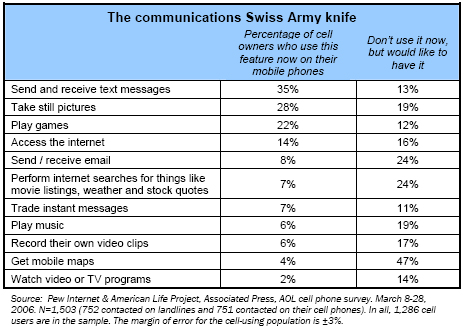
Asked if they would like the option of getting instant messages forwarded from their computers to their cell phones, 17% said they would like that.
In addition, the cell phone is becoming a fashion accessory for many users. Fully 65% have taken a step to personalize the phone in some way, such as by changing the wall paper or adding ring tones to the phone.
How devoted cell owners are
Asked their feelings about their cells, 29% of mobile phone owners said they could live without it, 45% said they would miss it, but could do without it, and 26% said they couldn’t live without it. Cell-only owners (those without landline phones) were the most likely to report complete dependence on their phones. But even among those who are cell-only users, fewer than half (47%) say they couldn’t live without their phone. Some 39% of cell-only users said they would miss it but could do without it and 14% said they could live without their cell.
The future of phone ownership
Those who have landline phones at home were asked: How likely are you to stop using your regular home phone and instead only use a cell phone? Some 8% said they were very likely to trade in their landline, and another 15% said they were somewhat likely to do so. More than half (55%) said they were not at all likely to go completely wireless with their phones.
This survey and the state of the cell phone population
The March 2006 survey with AP and AOL was designed to understand how people use their phones and profile those relying on a cell as their only phone. This survey cannot be used to estimate the size of the cell-owning population.
The most recent survey by the Pew Research Center for The People & The Press on overall cell ownership in October, 2004 showed that 66% of American adults have cell phones. This figure is undoubtedly higher today. Jupiter Research, a research firm, estimates there are 195 million cell phones in the United States.
Several recent studies have suggested that the size of the cell-only population hovers in the vicinity of 7%-9% of American adults.
Young adults engage their cells the most
The survey makes clear that younger cell users – those between ages 18 and 29 – have different experiences with their cell phones than do older Americans. Compared to older cell owners, young adults are more likely to reserve their calls until the hours that do not affect the minutes used in their rate plan; more likely to make spontaneous calls when they have free time they want to kill; more likely to use their cell phone to avoid disclosing where they are; and more likely to feel burdened by the intrusions the cell brings into their lives. In addition, they are more likely to experience sticker shock when monthly bills arrive.
Their overall feelings toward cell phones are more positive: 32% of the youngest cell phone users say they couldn’t live without their cell, compared with 18% of cell owners ages 30 and older who say that. Fully two thirds of younger cell owners (67%) say they always have their cell phone on. Among those who have both a cell and a landline, younger cell owners are more likely than older ones to prefer their cells: 49% of them use the cell more, compared with 24% of older cell owners.
It is not surprising, therefore, that the young are also the most likely to use extra cell phone features, or that they want to acquire whatever interactive media and communications capabilities are available to them.
For instance, 36% of younger cell users say they would like the option of having instant messages sent to their cells, compared with 19% of cell owners ages 30 and older who say they want this feature. If they could limit the IM forwards just to select members of their buddy lists, young cell owners would even more avidly embrace the feature: 50% say they would like that, compared with 34% of those 30 and older.
The gap between younger cell owners and others could grow in the near term. Fully 40% of landline users between the ages of 18 and 29 say they are very likely or somewhat likely to give up their landlines and go cell-only. That compares to 19% of landline owners 30 and older who are pondering a similar switch to cells.
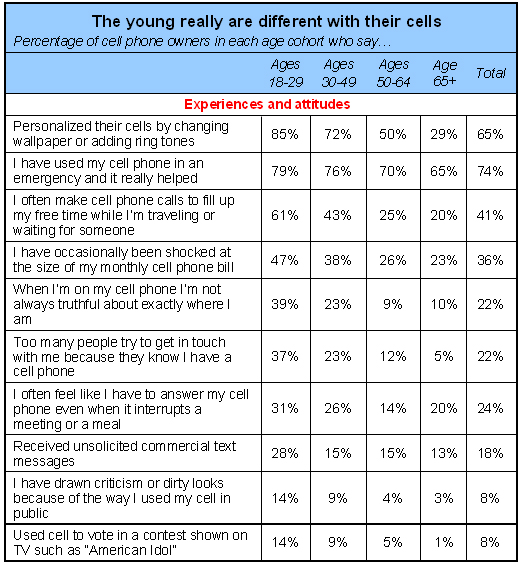
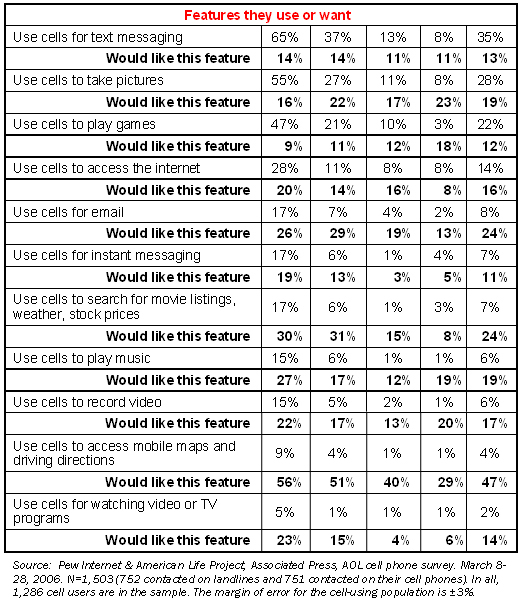
Those who have given up their land lines and only use cell phones are a breed apart
In this combined sample of landline and cell owners, we spoke to 200 people who only use cell phones.
Among respondents in our sample, this subpopulation is disproportionately male, under age 30, nonwhite, unmarried, and from households with modest amounts of income (households earning less than $30,000).
These cell-only users are strikingly different from the cell owners who also have landlines. By most measures, the phone of cell-only owners is a more valuable tool to them, it has a deeper impact on them, and it has a wider array of features.
The devotion of cell-only users to their phone is pronounced: 81% of cell-only owners say they leave their cell on all the time, compared to 48% of those who have both cells and landlines who say the mobile phone is on all the time.
Among those who have cells and landline phones, two thirds (67%) report they place most of their calls with their landline and 29% make most of their calls with their mobile phones. The rest report they use both types of phones about equally.
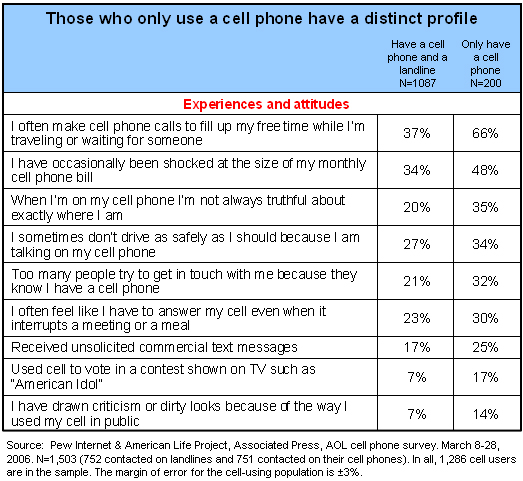
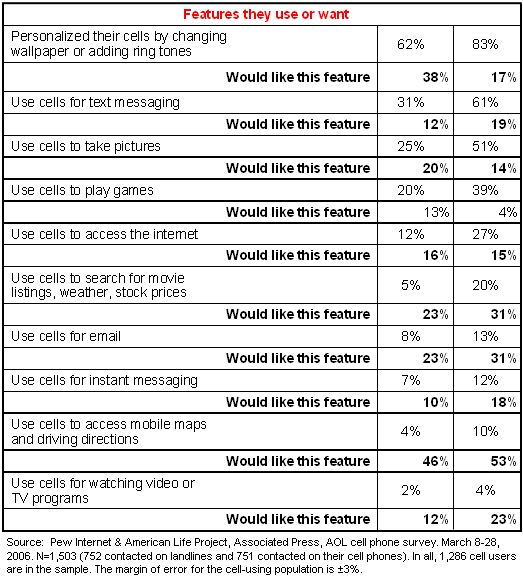
Men and women and their mobile world
There are gender-based differences among cell owners in some arenas. Men who own cells are more likely than women cell owners to say they couldn’t live without their mobile phone (34% of men report that, compared with 23% of women). On the other hand, women are more likely than men to say they have gained help from their cells in emergencies. Some other differences are highlighted in the table below.
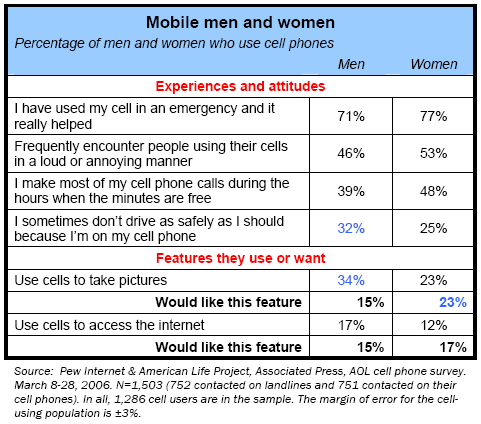
However, men and women who own cells are equally likely to send and receive text messages, to make calls to fill in their free time, to feel pressured to answer their phone whenever it rings even if it is an interruption, to be shocked on occasion at the size of the phone bill, to fake out others about where they are when they are using their cell, to have received texting spam, and to have used their cells to vote in an American Idol-type television contest.
Racial and ethnic differences
There are some notable differences among racial and ethnic groups when it comes to things they have experienced and do with their cell phones. Nonwhites are more likely to use their cells to fill in free time with calls, to report shock at some monthly cell bills; to feel obliged to callers even when the incoming calls are interruptions; and to say too many people try to get in touch with them because they know the person has a cell phone.
A considerable amount of the difference is attributable to the Hispanic population. It is important to note that this survey was conducted in English, so the results only apply to English-speaking Hispanics and are not projectable to the overall Latino population. In addition, the Latino population in America is relatively young, compared to other groups. Thus, at least some of the differences among ethnic groups found in this survey are linked to the age differences in the populations, rather than being attributable to the racial or ethnic background of respondents.
In their overall judgment, nonwhites are more likely than whites to say they can’t live without their cell phones: 32% of cell-owning nonwhites say that, compared with 24% of whites.
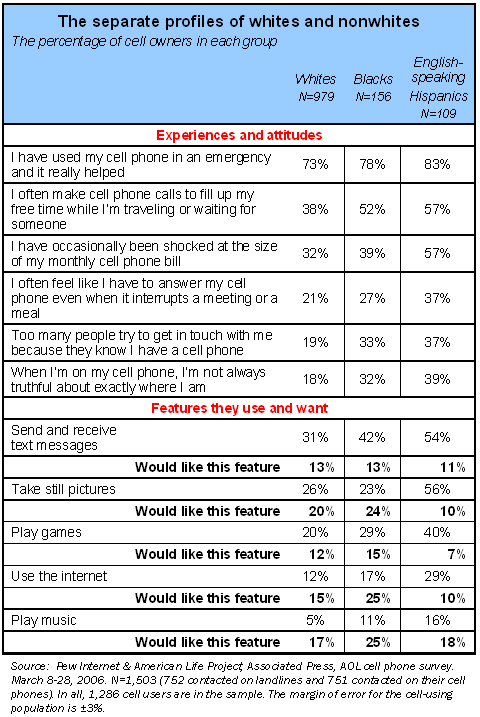
Implications of these findings
When it comes to assessing the social impact of the cell phone, this survey provides evidence that:
- Cell phones enable real-time action and engagement. One example of this is how people use their mobile phones to gain help in emergencies. Another example is evident when people use their phones to alert each other on the fly about all kinds of things – personal news, spur-of-the-moment events, gossip, changes in plans, convening of groups or meetings, and even political activity. One term now used to describe these communications is “smart mobbing” – which means that this technology allows people to pass along information, learn and act instantly on data that is important to them.1
- Cell phone use is encouraging people to reallocate portions of their time and their communications patterns. Many use their phones for spontaneous “calling around” when they have free time on their hands. They make these spontaneous calls when they are traveling, when they are waiting in line, and when they are walking down the street. It is likely this is adding to the volume and flow communication with others.
- Cell phone use is changing the character of our public spaces. It is now possible to be sitting on a train or walking through a park and hear some of the most intimate details of strangers’ lives because of the way they are chatting on their cells. To a great many people, this comes as an unwelcome consequence of their use of a mobile phone. Cell phones are blurring the boundaries between what is public and what is private.
- Cell phone use is changing expectations about when and how others are available to us. These results show how much cell owners have a love-hate relationship with their phones. On the one hand, they like that they can reach out to others no matter where they are. On the other hand, they are sometimes not too happy that others – perhaps including their bosses and work colleagues – can reach out to them at any place and time.
- This survey highlights the new ways that mobile media use might grow in the near future. There are notable numbers of cell owners who know about and want access to the new applications that are being installed in cell phones – internet browsing (especially for maps and directions), music playing, gaming, photo sharing, video watching, and, of course, instant messaging and texting. As we look into the future, it is possible to see how the cell phone might become the Swiss Army knife of media and communications for a considerable number of users.




